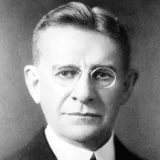
On May 11, 1911, the trustees elected Guy P. Benton, president of Miami University in Oxford, Ohio, as UVM’s twelfth president. Guy Potter Benton was born in Kenton, Ohio, on May 26, 1865. He graduated from Baker University and received a master’s degree from Ohio Wesleyan, followed by further study at the University of Wooster and in Berlin. In 1889 he married Dollar Konantz, and they had two daughters. He served as a city and state superintendent of public education in Kansas before he was named as the president of Upper Iowa University in 1899 and then elected president of Miami University in 1902.
The trustees chose Benton, an experienced academic administrator, because they felt UVM should become more completely a state university. While at Miami, Benton had served as president of the Ohio Conference of Colleges and Universities and as secretary-treasurer of the National Association of State Universities. Prior to his appointment to UVM, he had declined to serve as president of Boston University.
Benton was an innovative but somewhat aloof administrator. One of his first acts was to create the university senate. In his initial address to this body in September 1911, he signaled his no-nonsense approach when he announced he was appointing a committee on efficiency to ascertain, as soon as possible, just how much work each member of the educational staff is doing. Then Benton, the first Methodist president of UVM and a strict midwestern teetotaler, dropped another bombshell at the end of his address when he stated:
No more hateful spectacle confronts advancing civilization than a beer-sipping, wine-bibbing college or university professor. It is a safe prediction . . . that the college professor who drinks in public or private will not be tolerated beyond the meeting of the Board of Trustees next succeeding his discovery. And I say to you in perfect candor at this time, in order that there may be no misunderstanding from the beginning, that I will not serve on a teaching body with any man who uses intoxicating liquors in any form whatsoever.
Benton’s remarks antagonized many faculty members. During his first year in office, he implemented a systematic and long overdue reorganization of the academic departments in a manner that set the stage for the modern university, but this action also proved to be unpopular with many faculty members. Three new colleges were created — the College of Arts and Sciences, the College of Medicine, and the College of Engineering and Mechanic Arts. The deans of these colleges (plus the dean of the College of Agriculture) reported to the president, who served as “the administrative center of the whole.” The two newest departments — Education and Home Economics — were incorporated into the College of Arts and Sciences. In 1913 the state legislature appropriated eight thousand dollars to establish the Vermont Cooperative Extension Service, and home economics was transferred to the extension program.
During World War I, the campus was transformed as a Students’ Army Training Corps (SATC) unit was established, and temporary buildings were constructed to house enlisted men who took special training courses. Before the war ended, a total of 470 students enrolled in the SATC, another 2,250 took special courses, and 850 alumni and faculty served in the military.
In September 1917, the trustees granted President Benton a leave of absence to serve as director of the YMCA education department with the American army in France. After the war ended, Benton was asked to remain as the chief education director with the army of occupation in Germany. Realizing this would extend his time away from the university, he resigned as president in July 1919. In April 1920, he was awarded the Distinguished Service Medal by the United States government.
From 1921 to 1924, Benton served as president of the University of the Philippines where he became ill. He returned to the United States in poor health and died at the age of sixty-two on June 28, 1927.